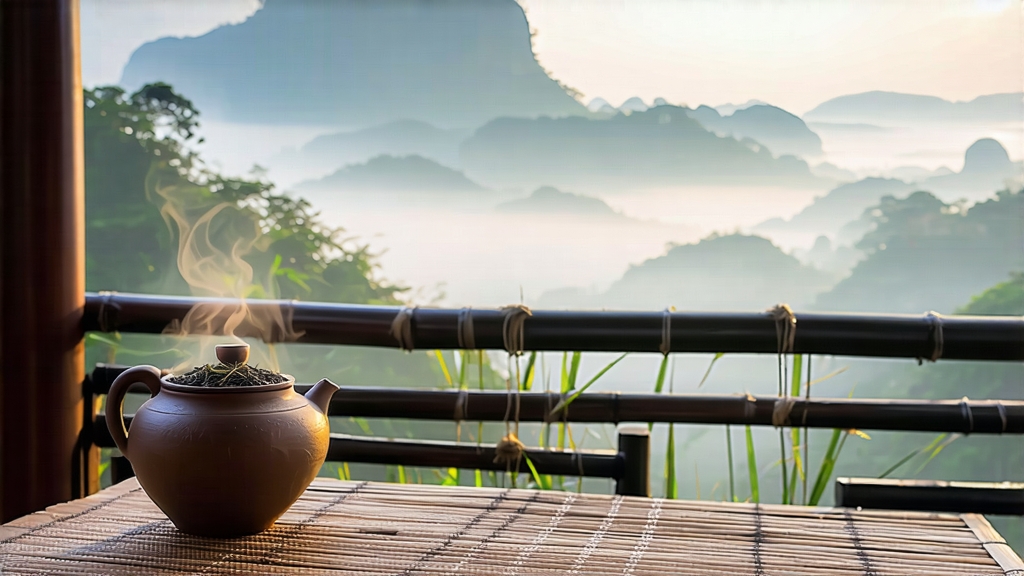
Tucked into the humid, karst-pocked mountains of southern China’s Guangxi Zhuang Autonomous Region, Liu Bao (literally “Six Forts”) is the quietest celebrity of the dark-tea family. While Pu-erh hoards the limelight, Liu Bao has spent four centuries maturing in clay jars, bamboo baskets and the cargo holds of merchant junks, slowly transmuting sun-wilted leaf into a deep, mellow liquor that smells of wet earth, betel nut and autumn orchards. For international drinkers who think “black tea” means English Breakfast, Liu Bao offers a passport to an older, wilder expression of Camellia sinensis—one that is fermented, aged and prized for its medicinal qi.
-
From Frontier Garrison to Global Cup
The name Liu Bao refers to the six defensive fortresses established during the Ming dynasty along the trade route between the tea-producing mountains of Cangwu County and the busy port of Wuzhou on the Xi River. By the Qing Qianlong era (1736–1795), compressed baskets of Liu Bao were already floating down-river to Guangzhou, where foreign clipper ships loaded them alongside silk and porcelain for shipment to Southeast Asia. In Malaya, tin-mine coolies drank it to ward off malaria and damp; in Hong Kong’s traditional tea houses it became the “cooling” counterpoint to dim sum. The 2005 renaissance of dark-tea investment in China finally pulled Liu Bao from diaspora obscurity back into domestic prestige; today, vintage 1970s baskets sell at auction for the price of a compact car. -
Terroir and Leaf Style
Guangxi’s subtropical monsoon climate—90 % humidity, red lateritic soil, temperature swings between 18 °C foggy dawns and 32 °C steamy afternoons—forces the tea bush to produce thick, leathery leaves rich in polyphenols and pectin. The indigenous cultivar is a large-leaf variety locally called “medium-leaf Yunnan-type,” genetically close to the Assamica strain but acclimated to lower latitude. Farmers pluck one bud with three to four leaves from late April to mid-May, when the spring rains pause and the leaf’s moisture content hovers around 75 %—ideal for the strenuous piling process that follows. -
Craft: Sun, Smoke, Steam and Microbes
Liu Bao’s production code, codified in Guangxi provincial standard DB45/T 947-2017, reads like a choreography for controlled decomposition.
a) Solar withering: Fresh leaf is spread on bamboo mats for 3–5 hours until it loses about 30 % weight, turning limp and grassy.
b) Kill-green: A short 3-minute tumble in a 200 °C drum halts oxidation but leaves enzymes latent—critical for later microbial fermentation.
c) Rolling: Light pressure ruptures cell walls without shredding the leaf, encouraging the release of amino acids.
d) Piling (wo dui): The signature step. Leaves are heaped 60–80 cm high in a humid room kept at 28–32 °C and 85 % humidity for 10–20 days. Workers turn the pile every two days, introducing oxygen and regulating temperature so that beneficial molds (Aspergillus niger, Blastobotrys adeninivorans) and yeasts (Cyberlindnera jadinii) bloom. The pile exhales a sweet, almost banana-like aroma; the leaf turns chestnut-brown and develops a sticky gloss.
e) Drying: After piling, the tea is either sun-dried on raised bamboo racks or basket-fired over low charcoal embers, reducing moisture to ≤ 12 %.
f) Compression: Traditionally, 50 kg of loose tea is steamed for 30 seconds, then packed into cylindrical bamboo baskets lined with wild taro leaves. The taro imparts a subtle vanilla note and prevents mold on the exterior.
g) Aging: Warehouses in Wuzhou maintain “wet warehouses” (75 % RH, 25 °C) for the first year to stabilize microbial activity, then transfer baskets to “dry warehouses” (60 % RH, 20 °C) for slow maturation. A minimum of three years is required before the tea earns the Liu Bao designation; connoisseurs seek 10-, 20- or even 40-year lots.
- The Flavor Arc: From Betel Nut to Red Dates
Young Liu Bao (